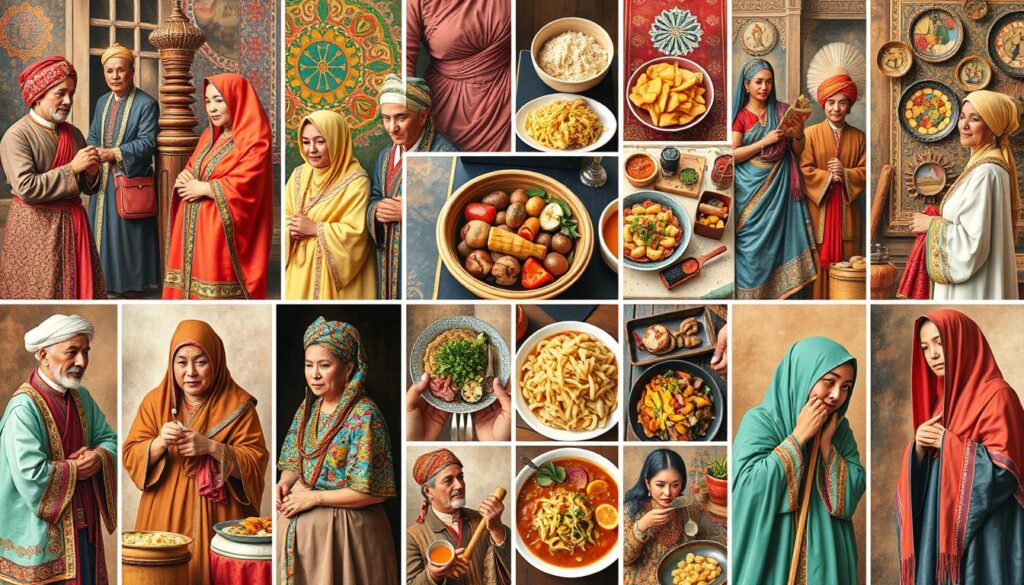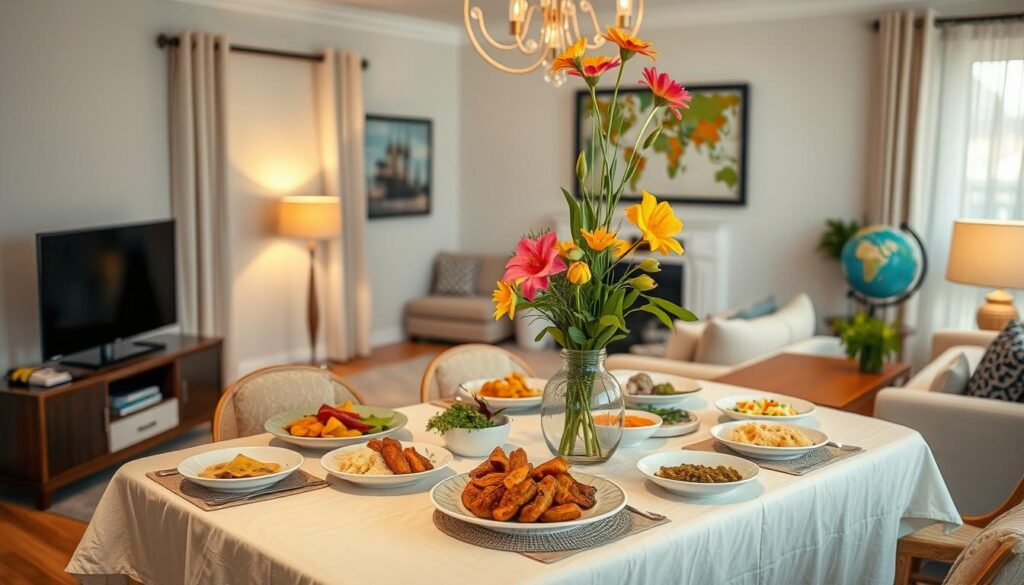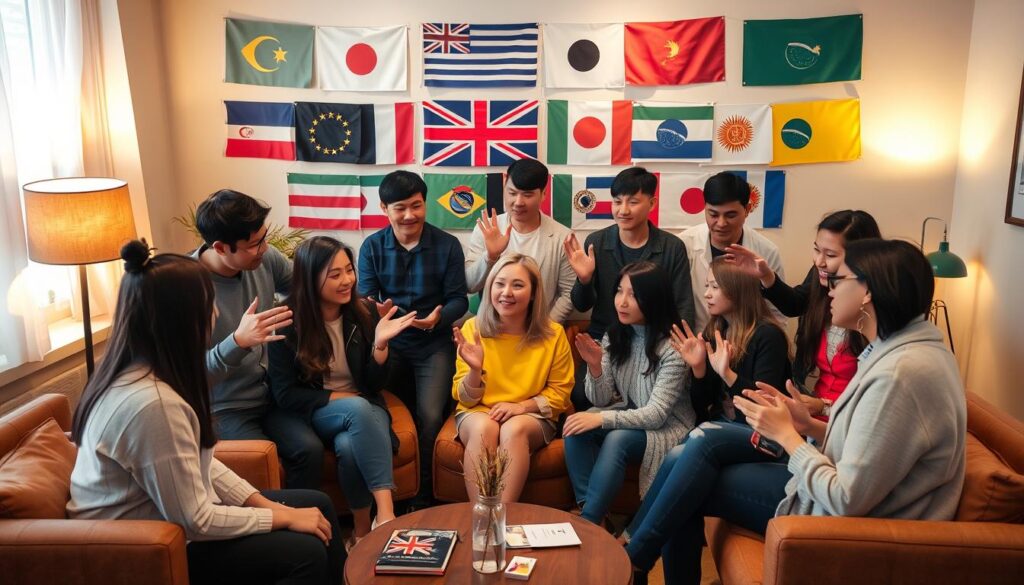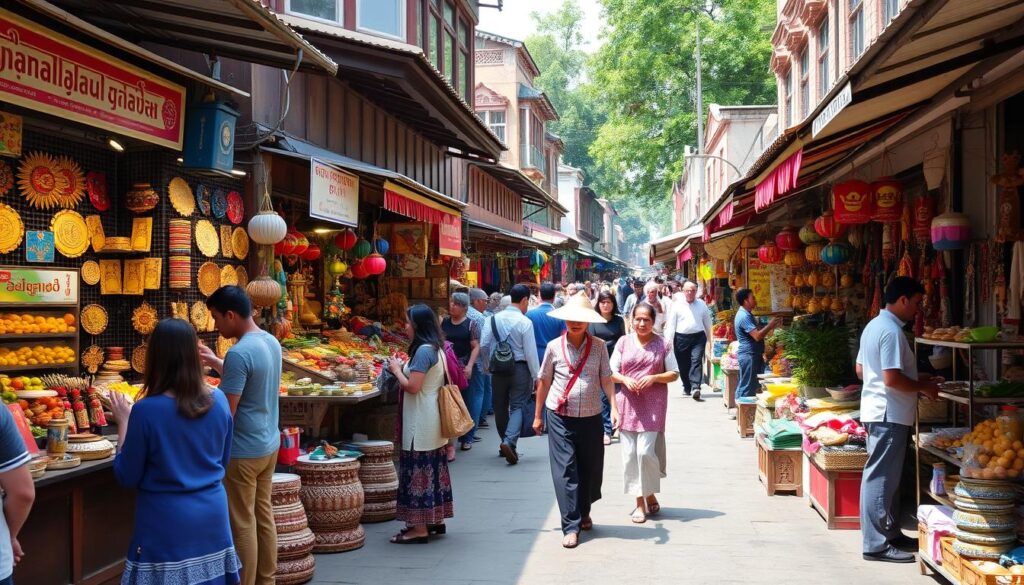Hosting guests from all over the world has been a rewarding experience for me. Each visit brings new cultural insights, laughter, and memories. I aim to make my home a place of warmth and genuine hospitality from the start.
Welcoming guests from different backgrounds needs care and preparation. It’s more than just a place to stay. It’s about making them feel at home, valued, and comfortable. Here, I’ll share my best tips for making your home welcoming to international guests.
Key Takeaways
- Cultivate cultural awareness and sensitivity to ensure a comfortable and inclusive environment for international guests.
- Anticipate and address the unique needs of your guests, such as dietary preferences, personal space considerations, and gift-giving traditions.
- Provide essential amenities and resources to help your guests navigate their surroundings and feel at home.
- Overcome language barriers through effective communication strategies and the use of multilingual resources.
- Foster cultural exchange and build lasting connections by sharing local experiences and creating shared moments.
By following these tips, you can make your home a center of cross-cultural hospitality. Here, international guests will feel welcomed, respected, and at ease. Let’s explore how to create a welcoming space for diverse travelers together.
Understanding Cultural Sensitivities and Customs
In the hospitality world, it’s key to embrace diverse customs and international etiquette. This makes guests from multicultural experiences feel welcome. Cultural diversity means knowing and respecting different cultural norms and values.
While Western cultures often focus on individualism, many Asian cultures prioritize collectivism. Training staff on cultural sensitivity can improve understanding and prevent stereotypes.
Religious and Dietary Considerations
Hotels can offer food that meets guests’ religious and dietary needs. This includes halal, kosher, or vegetarian options. Having multilingual staff shows a commitment to inclusivity and makes guests feel more at home.
Personal Space and Social Norms
It’s important to understand personal space and social norms in different cultures. Some cultures like being close, while others value their space. By recognizing and addressing unconscious biases, we can truly appreciate different cultures and offer unbiased hospitality.
Gift-Giving Traditions
Gift-giving customs vary a lot between cultures. Teaching staff about the right way to give gifts, like the meaning of certain colors or numbers, can help build strong connections with guests.
| Statistic | Value |
|---|---|
| Marriott International’s “Diversity & Inclusion” program | Enhances employee skills to serve diverse guests |
| Cultural sensitivity training | Can include workshops, awareness programs, and cross-cultural communication training for staff |
| Offering multilingual services in hotels | Demonstrates respect for guests’ cultures |
| Personalized experiences | Cater to individual guest preferences, enhancing cultural sensitivity |
| Feedback from guests | Provides valuable insights into ways hotels can better cater to cultural needs |
Essential Preparations Before Guests Arrive
Hosting international guests means making sure they feel welcome. Start by setting clear house rules. This helps avoid confusion and makes sure everyone knows what to expect.
Make sure your guests have everything they need to feel at home. This includes universal adapters, reliable WiFi, a global dictionary, toiletries, and snacks. Adding items familiar to different cultures can make their stay even better.
Be flexible with check-in and check-out times. Also, consider offering concierge services that understand different cultures. This way, you can make their stay memorable and comfortable.
“Implementing a mobile check-in solution can reduce front desk work by 40%, fraud by 75-90%, and increase guest satisfaction.”
To create a welcoming space, think about what your guests might need. Provide them with the right resources and support. This ensures they have a smooth and enjoyable stay.
Creating a Welcoming Space: Tips for Hosting International Guests
Hosting international guests means making them feel at home. From the moment they arrive, they should feel welcome and comfortable. By understanding cultural differences and offering the right amenities, you can create a space for meaningful connections.
Comfortable Room Setup
Make sure your guest room has everything they need. This includes comfy bedding, good lighting, and control over the temperature. Don’t forget the little things, like extra pillows and a tidy room. A cozy space helps guests relax and feel right at home.
Universal Amenities
Think about what your guests might need. Provide adapters, charging cables, and basic toiletries for their devices and personal care. Also, have teas, coffee, and snacks ready to make them feel cared for.
Welcome Package Essentials
Put together a welcome package with local tips, maps, and cultural insights. Include small gifts or local treats to show your appreciation. Use multilingual signs and guides to show respect for their languages.
“Providing a warm and inclusive environment for our international guests is not only a thoughtful gesture but also an opportunity to foster cultural exchange and create lasting connections.”
By focusing on comfort, inclusivity, and thoughtful hosting, you can make a lasting impression. Anticipate their needs, respect their preferences, and celebrate the diversity of your community. This way, you ensure a memorable and enriching stay for everyone.
Overcoming Language Barriers
Hosting guests from other countries can be challenging. It’s about finding ways to communicate and connect despite language differences. With the right steps, you can make your space welcoming to everyone.
Visual aids and translation apps are great tools. Use clear signs to share important info like rules or directions. Also, suggest translation apps like Google Translate to help with quick conversations.
Having staff who speak many languages is also helpful. They can help guests with their needs and questions. This makes the experience more personal and positive.
It’s important to understand cultural differences too. Pay attention to gestures, facial expressions, and body language. This helps you understand what your guests are feeling and need.
“Body language accounts for 93% of communication, emphasizing its importance in cross-cultural interactions.”
Overcoming language barriers takes time and effort. But with patience, adaptability, and a true desire to connect, you can make your guests feel at home. This way, you create lasting memories and connections.
- Utilize visual aids and translation apps to facilitate communication
- Hire or train multilingual staff to assist guests in their native language
- Observe non-verbal cues and practice active listening to understand cultural nuances
- Embrace patience, adaptability, and a genuine desire to connect with your international guests
Providing Essential Information and Resources
Being an international guest in the United States can be exciting. But, having reliable local info and resources is key to feeling at home. We’ll help you navigate the area, find the best spots, and more.
Local Transportation Guide
Exploring a new city can be tough. But, don’t worry, we’ve got you covered. The local transport system has buses and subways for easy travel. For a private ride, taxis and ride-sharing are just a tap away. Car rentals offer many options for longer trips or sightseeing.
Emergency Contacts
Having the right emergency numbers is crucial. We’ve listed important contacts like the police, fire department, and hospitals. If you need help, don’t hesitate to call.
Area Attractions and Services
Dive into the local culture and find the area’s hidden treasures. From famous museums to lively festivals, there’s plenty to see. We’ve also gathered info on international-friendly services to make your stay comfortable and fun.
| Attraction | Description | Location |
|---|---|---|
| The Statue of Liberty | Iconic landmark symbolizing freedom and democracy | New York City, NY |
| Golden Gate Bridge | Suspension bridge connecting San Francisco to Marin County | San Francisco, CA |
| The National Mall | Iconic national park in the heart of Washington, D.C. | Washington, D.C. |
We’re here to make your stay smooth and fun. If you have questions or need help, just ask. We’re ready to help you explore the area information and local culture.
Cultural Exchange Through Food and Dining
Embracing cultural sensitivity is key for multicultural experiences. Hosting international guests with diverse cuisine celebrates global traditions. Share local food stories and plan cooking classes or tours for a deep dive into culture.
Remember dietary restrictions and cultural food practices. Let guests share their food traditions. This exchange can break stereotypes and build strong bonds.
“The most valuable lesson I’ve learned working with Sanctuary Kitchen is the resilience displayed by the refugee and immigrant chefs. Cooking classes offer valuable opportunities for cultural exchange and foster connections among participants, chefs, and organizers.”
Sanctuary Kitchen uses refugee and immigrant chefs for cooking classes and more. These programs improve culinary skills and build community. They also help women in the workforce, aiming for more successful food businesses.
Cultural exchange programs, like the J-1 Visa, enrich American workers. They offer language support and help with cultural differences. This helps participants overcome cultural shock.
Exploring global cuisines fosters understanding and appreciation. By being open and curious, hosts can create unforgettable experiences. Food brings people together, crossing borders and cultures.
Building Trust and Long-lasting Connections
In the world of cross-cultural hospitality, building trust and lasting connections is key. Hotels must improve their communication strategies and show genuine empathy.
Active Listening Techniques
Effective communication begins with active listening. Hotel staff should understand guests’ needs and cultural preferences. They can do this by asking thoughtful questions and giving their full attention.
This approach helps meet guests’ immediate needs and builds trust and rapport.
Cultural Bridge Building
It’s important to overcome cultural biases and preconceptions. Hotel staff should reflect on their own assumptions and approach each guest with an open mind. This way, they can better meet the diverse needs of international guests.
Creating Shared Experiences
Memorable experiences can strengthen cross-cultural connections. Hotels can host cultural activities, events, or workshops. These allow guests and hosts to share traditions and perspectives.
“No one wants to be in a lawless place; hosts should protect, connect, and equalize their guests.”
Hotels can build trust and lasting connections by using active listening, empathy, and shared experiences. This approach to cross-cultural hospitality and communication strategies improves the guest experience. It also encourages repeat visits and positive word-of-mouth.
Managing Expectations and Avoiding Misunderstandings
In the hospitality world, clear communication is key, especially with guests from abroad. It’s important to set clear expectations about what services and amenities you offer. Also, knowing about local customs can prevent misunderstandings and make sure your guests have a great time.
Getting feedback from guests is a great way to spot where cultural mix-ups might happen. Use surveys, comment cards, or online feedback to hear from them. Quick action on this feedback can boost your reputation and build trust with your guests. It’s also vital to keep updating your cultural training based on what guests say.
Encourage guests to speak up and offer many ways for them to share their thoughts or questions. This helps improve their stay. By tackling issues early and keeping a focus on cultural sensitivity, you create a welcoming space. This space helps build strong connections with your international guests.





